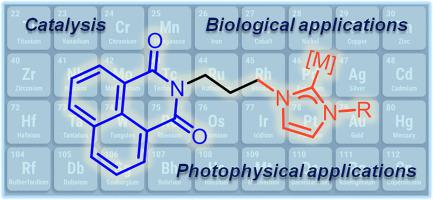Coordination Chemistry Reviews ( IF 20.3 ) Pub Date : 2021-09-20 , DOI: 10.1016/j.ccr.2021.214201 Liza Roos 1 , Frederick P. Malan 1 , Marilé Landman 1

|
The following review provides an account of all 82 N-heterocyclic carbene metal complexes containing a naphthalimide-NHC moiety, incorporating either an imidazolylidene, imidazolinylidene or benzimidazolylidene ligand, reported in literature. Only three of these are biscarbene complexes. Naphthalimide-NHC complexes constitute a very successful class of compounds that has been applied across many fields, thus providing a focal point of coinciding interest that may appeal to a wide audience and incite future work. Herein, the complexes are divided among those with the naphthalimide moiety tethered via a (benz)imidazol(in)ylidene N-atom and those where it is bonded to the NHC backbone, since the electronic properties and conformations of the two classes vary considerably. These complexes are interesting target molecules that rely on common to more advanced synthetic methods for preparation, including post-synthetic modification in some instances. Due to their bulkiness, these complexes may also exhibit notable conformations in the solid state, with π-π stacking interactions contributing to their fascinating properties. Catalytic applications for this class of complexes are limited in literature and include only the Larock heteroannulation reaction and Suzuki-Miyaura coupling reaction. Pd(II) complexes were primarily studied as catalysts for these reactions. Au(I), Cu(I), Ag(I), Rh(I) and Ru(II) complexes were applied in a biological context, with bis-naphthalimide Ag(I) and bis-NHC Au(I) complexes showing the greatest activity against cancerous colorectal (HT-29), breast (MCF-7) or lung (A549) cells. The naphthalene rings of the naphthalimide moiety in the complexes were responsible for π-π stacking interactions and binding of complexes to DNA through intercalation. Rh(I), Ru(II) and Ag(I) complexes successfully inhibited gram positive bacterial strains. In addition, Au(I), Cu(I), Ag(I), Rh(I), Ir(I) and Ir(III) complexes exhibited photoluminescent properties, emitting in red, blue-green or blue regions with either phosphorescence or fluorescence lifetimes. The unique properties of naphthalimide-NHC complexes allowed for the theranostic application in selected anticancer studies, which has been illustrated by imaging of cytotoxic luminescent complexes. Integration of the photophysical properties with catalytic processes, in photocatalysis or in additional biological applications e.g. photodynamic therapy, is envisaged for these naphthalimide-containing complexes in future endeavours.
中文翻译:

萘酰亚胺-NHC 配合物:催化、生物和光物理应用中的合成和性能
以下综述提供了文献中报道的所有 82 种 N-杂环卡宾金属配合物,这些配合物包含萘酰亚胺-NHC 部分,结合了咪唑亚基、咪唑啉亚基或苯并咪唑亚基配体。其中只有三个是双卡宾配合物。Naphthalimide-NHC 复合物构成了一类非常成功的化合物,已应用于许多领域,因此提供了一个可能吸引广泛受众并激发未来工作的一致兴趣焦点。在本文中,复合物被划分为萘酰亚胺部分通过一个(苯)咪唑(亚)亚基 N 原子和那些与 NHC 主链键合的 N 原子,因为这两类的电子特性和构象差异很大。这些复合物是有趣的目标分子,它们依赖于更先进的合成方法进行制备,在某些情况下包括合成后修饰。由于它们的体积庞大,这些复合物在固态下也可能表现出显着的构象,π-π 堆积相互作用有助于它们的迷人特性。这类配合物的催化应用在文献中受到限制,仅包括 Larock 杂环化反应和 Suzuki-Miyaura 偶联反应。Pd(II) 配合物主要用作这些反应的催化剂。Au(I)、Cu(I)、Ag(I)、Rh(I) 和 Ru(II) 配合物应用于生物环境中,双萘二甲酰亚胺 Ag(I) 和双 NHC Au(I) 复合物显示出对癌性结直肠 (HT-29)、乳腺癌 (MCF-7) 或肺癌 (A549) 细胞的最大活性。复合物中萘酰亚胺部分的萘环负责 π-π 堆积相互作用和复合物通过嵌入与 DNA 结合。Rh(I)、Ru(II) 和 Ag(I) 复合物成功抑制革兰氏阳性细菌菌株。此外,Au(I)、Cu(I)、Ag(I)、Rh(I)、Ir(I) 和 Ir(III) 配合物表现出光致发光特性,在红色、蓝绿色或蓝色区域发光并带有磷光或荧光寿命。萘二甲酰亚胺-NHC 复合物的独特性质允许在选定的抗癌研究中进行治疗诊断,这已通过细胞毒性发光复合物的成像得到说明。









































 京公网安备 11010802027423号
京公网安备 11010802027423号